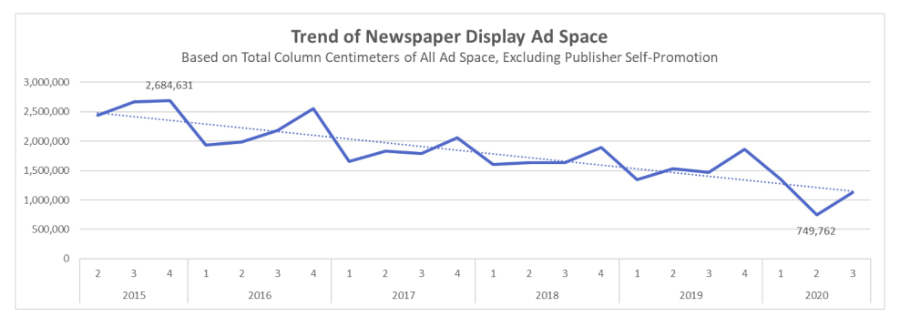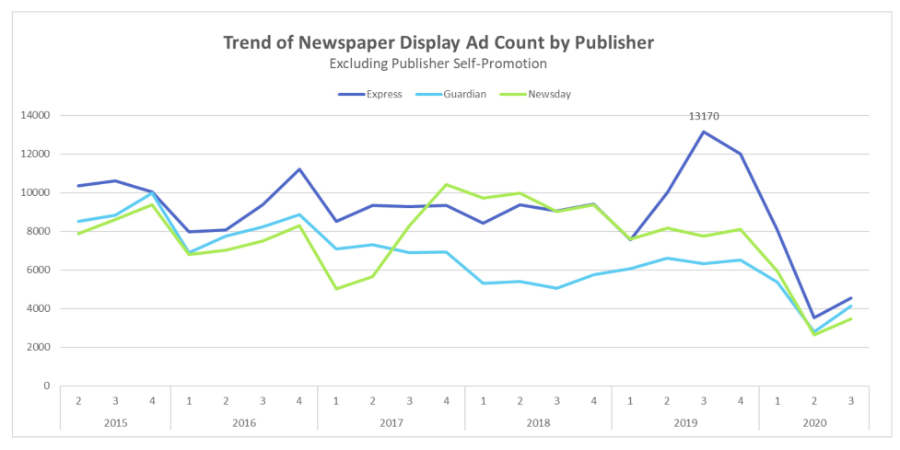
Above: The road ahead. Illustration by ra2studio/DepositPhotos.
BitDepth#1278 for December 03, 2020
Years ago, I told a media manager that the time to build a boat to a new destination is while the docks are busy with commerce.
Today, the docks are burning and money for building new metaphorical ships is in dramatically short supply.
Media InSite, which has monitored advertising placement in print since 2015, shared a disturbing picture of the steady decline on every measurement of advertising revenue with me with a series of graphs.
The aggregate of display ad space dropped from a peak of 2.6 million column centimetres in the fourth quarter of 2015 to 0.75 million in the second quarter of 2020. Rallying after lockdowns suggests that the fourth quarter will end at roughly 1.2 million column centimetres.
Display ad count was aggressively competitive over the five years, but shrank steadily.
Full page ad counts have declined in the aggregate between 2015 and 2020. Those advertising dollars haven’t evaporated; they have migrated to social media and programmatic advertising.
Kill Google ads
Over at TechNewsTT, a yearlong experiment with programmatic advertising through Auttomatic, the WordPress parent company, yielded the dramatic sum of US$5. Unsurprisingly, that experiment goes away in 2021.
Google Ads pay about the same, so it’s a continuing source of astonishment to me that local news websites fill their inventory of website ad spaces with the weeds of Internet advertising.
That creates two vastly different prices for ad placement online.
For a business that’s been extraordinarily smart about pricing advertising space in print and broadcast for decades, selling ad space for pennies seems…unusual.
Since publishers and broadcasters can’t easily stop Facebook and Google from profiting off their content, it’s double jeopardy letting Google ads target their web pages.
Refocus post pages
Post pages are largely an afterthought in local news website design.
On TechNewsTT, readers overwhelmingly arrive at a story via a link embedded elsewhere. Secondary exploration will be either through a “Related Posts” display or a click to the home page to see what’s current.
If that’s true for your website, then there are three actionable items there for online publishers.
First, ensure that your individual post page design offers more opportunities for exploration.
If your editorial provokes comment, then make recent comments prominent to visitors.
Effective related posts are crucial to making your posts more relevant to readers. Outbrain style related posts links are garbage, robbing the site of views.
If metrics show a trend of click-throughs to related stories, consider embedding related posts links within the body of the post itself, instead of at the pages’ end.
If secondary exploration favours the home page, make the “above the fold,” the first screenful of material the viewer sees, as effective as possible.
I work to make that impactful and fresh.

Who’s clicking the links?
I track Facebook, Twitter and Linked-In sources, but not WhatsApp.
Recent surges in untrackable views are likely to have come from links shared in WhatsApp groups. That’s another opportunity for audience engagement.
Teaser and summary emails were a great hook for readership, but response to emails have generally fallen off dramatically in recent years.
Getting readers to sign up for a newsletter is tough, but producing one that gets regular views is a job. I’m inching toward that, sending out an automated email of aggregated links once a week, meanwhile.
Reorient your purpose.
Media houses aren’t in competition with each other, they are in competition with disinterest, sketchy reading habits and a world of distracting, often contradictory quasi-information.
Media managers should be less concerned with competition and embrace the challenge of expanding the reach of news and cultivating an appetite for verified, curated information.
It’s pointless fussing over who bought which paper when most of the potential audience isn’t buying any paper at all.



